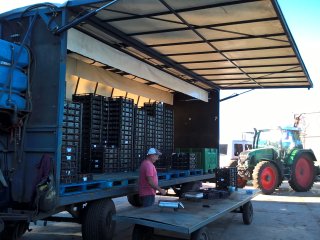
Transport practices for strawberry
The transport of fresh products generally takes place in (refrigerated) trucks, reefer containers or by plane. Checks and proper loading are always important to maintain good (temperature) conditions for the product during transport. For strawberries, refrigerated transport is often necessary. Trucks and reefers can maintain a low temperature, but do not have enough cooling capacity to lower the product temperature. Therefore, products must be pre-cooled before entering the refrigerated truck or reefer. During transport and waiting periods, the load must be well covered to protect against dust, sun and rain. Careful driving and careful product handling is essential to prevent damage to products due to mechanical action.

Timely transport is essential
Strawberries are packed on the farm or packhouse in close distance to the farm. Timely transport to the farm or packhouse with pre-cooling facility is necessary as quickly obtaining a low temperature is essential for the keeping quality of strawberry. Pre-cooling of the product, usually to a temperature between 0 and 1 ºC, is absolutely necessary before the product enters the refrigerated truck for further transport. Strawberries for distant (export) markets are shipped by air due to their limited shelf life. Foil laminated thermal blankets can be used to cover an entire pallet if cold chain temperature cannot be guaranteed, for example during transfer at the airport. Ideally, strawberries are transported to the final market on the day of picking.



